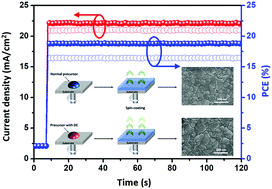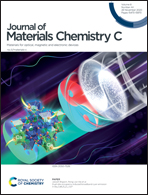Crystallization management for high-performance perovskite solar cells by introducing an antisolvent into the perovskite precursor†
Abstract
Scientific techniques on perovskite solar cells have been significantly developed since the emergence of organic–inorganic hybrid perovskite materials. An antisolvent strategy for preparing perovskite films has been widely used, which is important to improve the photovoltaic performance. In this work, an appropriate amount of diethyl ether (DE), which is usually used as an antisolvent, is added into the perovskite precursor to promote the crystallization of perovskite throughout the entire process. Due to the fast evaporation rate and Lewis base nature of DE, a quicker nuclei formation and retarded nuclei growth of the perovskite can be induced. Consequently, the quality of the perovskite film is improved with enlarged grain size and enhanced crystallinity. Based on this technique, the optimized perovskite solar cells exhibit an improved 19.2% power conversion efficiency (PCE), whereas the control devices only have a lower PCE of 16.8%. In addition, the environmental stability of the perovskite solar cells is also enhanced due to the decreased intrinsic defects of the perovskite film. After 500 h storage in ambient air (approximately 25 °C and 30% relative humidity) without encapsulation, the developed group maintains about 84% of their initial PCE, which is higher than that (77%) of the control group.



 Please wait while we load your content...
Please wait while we load your content...